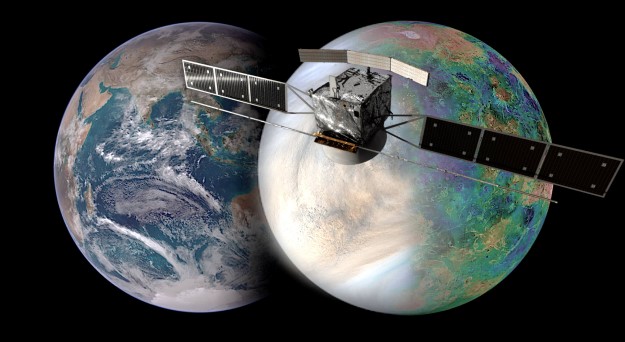De Europese ruimtevaartorganisatie ESA heeft de Venus-satelliet EnVision geselecteerd als vijfde medium-class missie binnen haar Cosmic Vision programma. Daarmee begint een nieuw tijdperk van onderzoek naar Venus—NASA kondigde vorige week al twee nieuwe missies aan naar onze zusterplaneet. SRON en TU Delft zijn onderdeel van het EnVision-consortium.
Het ruimtevaartuig gaat aan het begin van het volgend decennium in een baan om Venus draaien, waarbij het metingen doet aan de atmosfeer, het oppervlak en de ondergrond. Een van de hoofdvragen is waarom en wanneer de Aarde en Venus zulke verschillende planeten zijn geworden. Terwijl de Aarde oceanen heeft en een gematigd klimaat dat geschikt is voor leven, is Venus kurkdroog en loopt het kwik dankzij een extreem broeikaseffect vrijwel overal op tot bijna 500 graden Celsius.
Spectrometers op EnVision gaan gassen, nevels en wolken in de atmosfeer bestuderen. Een radar brengt het oppervlak en de ondergrond in beeld, waarbij onderzoekers vooral vulkanen in de gaten houden omdat veranderingen kunnen duiden op recente uitbarstingen. SRON en TU Delft slaan de handen ineen om hun expertise op het gebied van spectrometer-detectoren en de Venus-atmosfeer in te zetten.
‘Deze missie gaat ons begrip van de atmosfeer van Venus een enorme boost geven,’ zegt Michiel Min, leider van SRON’s exoplanetenprogramma. ‘Venus is enorm interessant omdat hij zo op de Aarde lijkt, maar in zoveel aspecten zo anders geworden is. Met EnVision gaan we een schat aan kennis opdoen voor toekomstige studies van planeten rondom andere sterren, maar vooral ook van onze eigen aardatmosfeer.’
Daphne Stam (universitair hoofddocent planeetwetenschappen TU Delft): ‘Hoewel Venus van alle planeten het dichtst bij ons staat, is ze door haar dikke atmosfeer en ongebroken wolkendek nog een raadsel voor onderzoekers. Met EnVision kunnen we de verbanden tussen de gassen in de atmosfeer, de wolken van zwavelzuur, en het met vulkanen bezaaide, gloeiende oppervlak in detail bestuderen. Dat geeft ons meer inzicht in de evolutie van aardachtige planeten.’
Credit header image: NASA / JAXA / ISAS / DARTS / Damia Bouic / VR2Planets
Venus orbiter EnVision selected as new ESA mission
The European Space Agency (ESA) has selected the Venus orbiter EnVision as the fifth medium-class mission within its Cosmic Vision program. It marks the beginning of a new era of Venus exploration—last week NASA already announced two new missions to Earth’ sister planet. SRON and TU Delft are part of the EnVision consortium.
The spacecraft will orbit Venus during the early 2030s, taking measurements of the atmosphere, the surface and the subsurface. One of the main questions is why and when Earth and Venus became such different planets. While the Earth has oceans and a mild climate suitable for life, Venus is bone-dry and in most places the temperature rises to almost 500 degrees Celsius—due to an extreme greenhouse effect.
EnVision will use spectrometers to study gases, nebulae and clouds in the atmosphere. A radar maps the surface and subsurface, where researchers keep a close eye on volcanoes because any changes could indicate recent eruptions. SRON and TU Delft join forces to deploy their expertise in the field of spectrometer detectors and the Venusian atmosphere.
‘This mission will give a large boost to our understanding of Venus’ atmosphere,’ says Michiel Min, head of SRON’s exoplanet program. ‘Venus is very interesting because it is similar to Earth, but has become so different in so many aspects. With EnVision we will gain a wealth of knowledge for future studies of planets around other stars, and especially of our own Earth’s atmosphere.’
Daphne Stam (associate professor of planetary sciences at TU Delft): ‘Although Venus is the closest planet to us, it remains a mysterious world to researchers because of its thick atmosphere and unbroken cloud cover. With EnVision, we can perform detailed studies of the connections between the gases in the atmosphere, the sulfuric acid clouds and the volcano-rich, glowing surface. It gives us more insight into the evolution of earth-like planets.’


